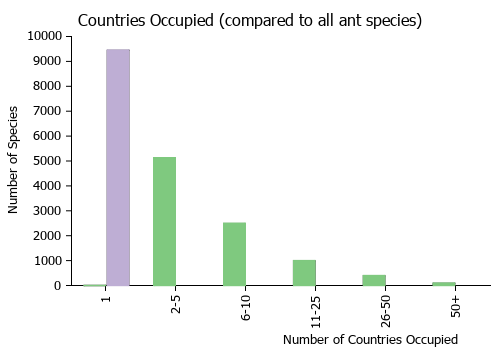Pseudomyrmex exoratus
| Pseudomyrmex exoratus | |
|---|---|
| Scientific classification | |
| Kingdom: | Animalia |
| Phylum: | Arthropoda |
| Class: | Insecta |
| Order: | Hymenoptera |
| Family: | Formicidae |
| Subfamily: | Pseudomyrmecinae |
| Genus: | Pseudomyrmex |
| Species group: | elongatulus |
| Species: | P. exoratus |
| Binomial name | |
| Pseudomyrmex exoratus Ward & Branstetter, 2022 | |
Pseudomyrmex exoratus is known from only three low-elevation localities in southern Mexico (in Oaxaca and Chiapas) and one collection from Honduras. Janzen collected two series at Temascal, Oaxaca, labeled 2.ii.1964 II and 2.ii.1964 IV (the latter including alate queens and males), plus a single queen on 10 Jan 1964, for which the label states ‘flew into car, at house’. Little is known about the biology of this species although it is presumed to nest in dead twigs, like most other members of the P. elongatulus group. The robust profemur suggests that it might occupy rather hard dead wood.
Identification
Medium-sized species (LHT 0.78–0.84), with notably elongate head (CI 0.67–0.69) and eyes (see REL and REL2 values); frontal carinae separated by basal scape width or slightly less; ocelli prominent (Fig. 14); metanotal groove conspicuously impressed; dorsal face of propodeum rounding insensibly into declivitous face, the two subequal in length; petiole relatively slender (PLI 0.52–0.56, PL/HL 0.51–0.52), in profile the weakly convex anterodorsal face of petiole ascending gradually to summit in the posterior half of node, then rounding into steeper posterior face; profemur relatively robust (FI 0.46–0.49); hind leg short, relative to head length (LHT/HL 0.65–0.67). Head sublucid, anterior half densely punctulate with shiny interspaces, becoming sparsely punctulate-coriarious on vertex. Standing pilosity sparse, absent from propodeum and mesonotum (MSC 3–4). Light orange-brown, with dark brown anterolateral patches on abdominal tergite 4 (first gastric tergite) and a transverse band on abdominal tergite 6 (gastric tergite 3); distal half of anterior face of metafemur weakly infuscated.
This light orange-brown species is easily recognized by its exceptionally elongate head (worker CI 0.67–0.69, queen CI 0.55–0.59), which is unlike that of any other species in the P. elongatulus group. Pseudomyrmex exoratus also has a rather robust profemur (worker FI 0.46–0.49, queen FI 0.47–0.49) and distinctive maculation on the gaster: dark anterolateral patches on abdominal tergite 4 and a transverse band on abdominal tergite 6. Our UCE phylogeny shows P. exoratus to be closely related to the more common and widespread species, Pseudomyrmex elongatulus (Fig. 1). Both species occur sympatrically at the type locality of P. exoratus.
Keys including this Species
Distribution
Latitudinal Distribution Pattern
Latitudinal Range: 18° to 15°.
| North Temperate |
North Subtropical |
Tropical | South Subtropical |
South Temperate |
- Source: Ward & Branstetter, 2022
Distribution based on Regional Taxon Lists
Neotropical Region: Honduras, Mexico (type locality).
Distribution based on AntMaps
Distribution based on AntWeb specimens
Check data from AntWeb
Countries Occupied
| Number of countries occupied by this species based on AntWiki Regional Taxon Lists. In general, fewer countries occupied indicates a narrower range, while more countries indicates a more widespread species. |

|
Estimated Abundance
| Relative abundance based on number of AntMaps records per species (this species within the purple bar). Fewer records (to the left) indicates a less abundant/encountered species while more records (to the right) indicates more abundant/encountered species. |

|
Biology
Castes
Phylogeny
Relationships among Pseudomyrmex elongatulus group species based on Ward & Branstetter (2022).
| Pseudomyrmex |
| ||||||||||||||||||||||||||||||||||||||||||||||||||||||||||||||||||||||||||||||||||||||||||
Nomenclature
The following information is derived from Barry Bolton's Online Catalogue of the Ants of the World.
- exoratus. Pseudomyrmex exoratus Ward & Branstetter, 2022: 24, figs. 14, 24 (w.) MEXICO (Oaxaca).
Type Material
Holotype Worker. MEXICO Oaxaca: Temascal, 25 m, 2 Feb 1964, at house, D. H. Janzen (UNAM) (CASENT0863539). Paratypes: series of workers, same data as holotype (CASC, CZUG, IEXA, JTLC, LACM, MCZC, PSWC, UCDC, USNM).
Description
References
- Ward, P.S., Branstetter, M.G. 2022. Species paraphyly and social parasitism: Phylogenomics, morphology, and geography clarify the evolution of the Pseudomyrmex elongatulus group (Hymenoptera: Formicidae), a Mesoamerican ant clade. Insect Systematics and Diversity 6(1), 4: 1-31 (doi:10.1093/isd/ixab025).